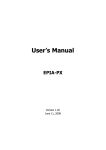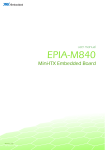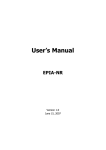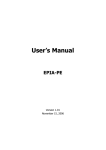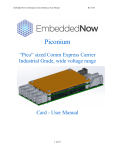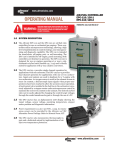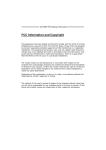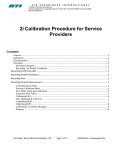Download User`s Manual - RS Components International
Transcript
User’s Manual VB7001 Version 1.12 April 20, 2010 Copyright Copyright © 2005-2008 VIA Technologies Incorporated. All rights reserved. No part of this document may be reproduced, transmitted, transcribed, stored in a retrieval system, or translated into any language, in any form or by any means, electronic, mechanical, magnetic, optical, chemical, manual or otherwise without the prior written permission of VIA Technologies, Incorporated. Trademarks All trademarks are the property of their respective holders. PS/2 is a registered trademark of IBM Corporation. Award BIOS is a registered trademark of Phoenix Technologies Ltd. Disclaimer This item incorporates copy protection technology that is protected by U.S. patents and other intellectual property rights of Rovi Corporation. Reverse engineering and disassembly are prohibited. FCC-B Radio Frequency Interference Statement This equipment has been tested and found to comply with the limits for a class B digital device, pursuant to part 15 of the FCC rules. These limits are designed to provide reasonable protection against harmful interference when the equipment is operated in a commercial environment. This equipment generates, uses and can radiate radio frequency energy and, if not installed and used in accordance with the instruction manual, may cause harmful interference to radio communications. Operation of this equipment in a residential area is likely to cause harmful interference, in which case the user will be required to correct the interference at his personal expense. Notice 1 The changes or modifications not expressly approved by the party responsible for compliance could void the user's authority to operate the equipment. Notice 2 Shielded interface cables and A.C. power cord, if any, must be used in order to comply with the emission limits. Tested To Comply With FCC Standards FOR HOME OR OFFICE USE Safety Instructions 1. Always read the safety instructions carefully. 2. Keep this User's Manual for future reference. 3. Keep this equipment away from humidity. 4. Lay this equipment on a reliable flat surface before setting it up. 5. The openings on the enclosure are for air convection hence protects the equipment from 6. Make sure the voltage of the power source and adjust properly 110/220V before 7. Place the power cord in such a way that people cannot step on it. Do not place anything 8. Always unplug the power cord before inserting any add-on card or module. 9. All cautions and warnings on the equipment should be noted. overheating. DO NOT COVER THE OPENINGS. connecting the equipment to the power inlet. over the power cord. 10. Never pour any liquid into the opening. Liquid can cause damage or electrical shock. 11. If any of the following situations arises, get the equipment checked by a service personnel: • The power cord or plug is damaged • Liquid has penetrated into the equipment • The equipment has been exposed to moisture • The equipment has not works well or you cannot get it work according to User's • The equipment has dropped and damaged • If the equipment has obvious sign of breakage Manual. 12. DO NOT LEAVE THIS EQUIPMENT IN AN ENVIRONMENT UNCONDITIONED, OR IN A STORAGE TEMPERATURE ABOVE 60oC (140oF). THE EQUIPMENT MAY BE DAMAGED. Caution: Only use the appropriate battery specified for this product. Do not reuse, recharge, or reheat an old battery. Do not attempt to force open the battery. Do not discard used batteries with regular trash. Discard used batteries according to local regulations. B OX C ONTENTS One One One One One VIA Mini-ITX mainboard Quick Installation Guide ATA-133/100 IDE ribbon cable driver and utilities CD IO bracket i T ABLE OF C ONTENTS Box Contents............................................................................ i Table of Contents .................................................................... ii Chapter 1 ............................................................................... 1 Specifications ....................................................................... 1 Mainboard Specifications ....................................................... 2 Mainboard Layout ................................................................. 4 Back Panel Layout ................................................................. 5 Chapter 2 ............................................................................... 7 Installation........................................................................... 7 CPU ..................................................................................... 8 Memory Module Installation ................................................. 10 Connecting the Power Supply ............................................... 11 Back Panel Ports ................................................................. 12 Connectors ......................................................................... 14 Jumpers ............................................................................. 19 Slots.................................................................................. 20 Chapter 3 ............................................................................. 21 BIOS Setup ........................................................................ 21 Entering Setup ................................................................... 22 Control Keys....................................................................... 23 Navigating the BIOS Menus .................................................. 24 Getting Help ....................................................................... 25 Main Menu ......................................................................... 26 Standard CMOS Features ..................................................... 28 IDE Drives ......................................................................... 29 Advanced BIOS Features...................................................... 30 CPU Feature ....................................................................... 33 Hard Disk Boot Priority ........................................................ 35 Advanced Chipset Features .................................................. 36 AGP & P2P Bridge Control .................................................... 38 CPU & PCI Bus Control ........................................................ 40 TV Output Connector........................................................... 41 Integrated Peripherals ......................................................... 42 Super IO Device ................................................................. 44 ii Power Management Setup .................................................... Peripheral Activities ............................................................ IRQs Activities .................................................................... PNP/PCI Configurations ....................................................... IRQ Resources .................................................................... Frequency / Voltage Control ................................................. Load Fail-Safe Defaults ........................................................ Load Optimized Defaults ...................................................... Set Supervisor / User Password ............................................ Save & Exit Setup ............................................................... Exit Without Saving ............................................................. Chapter 4 ............................................................................. Driver Installation ............................................................... Driver Utilities .................................................................... CD Content ........................................................................ iii 45 47 50 51 53 54 58 59 60 62 63 65 65 66 68 This page is left intentionally blank. iv CHAPTER 1 Specifications The ultra-compact and highly integrated VIA VB7001 uses the Mini-ITX mainboard form-factor developed by VIA Technologies, Inc. as part of the company’s open industry-wide total connectivity initiative. The mainboard enables the creation of an exciting new generation of small, ergonomic, innovative and affordable embedded systems. Through a high level of integration, the Mini-ITX occupy 66% of the size of FlexATX mainboard form factor. The mainboard comes with an embedded VIA Processor, boasting of ultra-low power consumption, cool and quiet operation. 1 Chapter 1 M AINBOARD S PECIFICATIONS CPU • ® VIA C7 -D 1.5GHz NanoBGA2 Processor Chipset • VIA CN700 North Bridge • VIA VT8237R Plus South Bridge Graphics • Integrated UniChrome™ Pro AGP with MPEG-2 Acceleration Audio • VIA VT1618 AC'97 Codec Memory • 1 x DDR2 533 DIMM slot (up to 1 GB) Expansion Slot • 1 x PCI slot • 2 x UltraDMA 133/100/66 connectors IDE Serial ATA • 2 x SATA connectors LAN • VIA VT6103L 100/10 Base-T Ethernet PHY TV-Out • VIA VT1622AM SDTV Encoder Onboard I/O Connectors • 2 x USB connectors for 4 additional USB 2.0 ports • 1 x Front Panel audio connector (Line-out and Mic-in) • 1 x Front Panel pin header • 1 x CIR connector (Switchable for KB/MS) • 2 x Fan connectors (CPU Fan and System Fan) • 1 x FIR pin header • 1 x SMBus pin header • 1 x Optical S/PDIF out connector 2 Specifications • 1 x Buzzer • 1 x ATX Power connector Back Panel I/O Ports • 1 x PS/2 mouse port and 1 x PS/2 keyboard port • 1 x RJ-45 LAN port • 1 x Serial port • 1 x VGA port • 2 x USB 2.0 ports • 3 x Audio Jacks: Line-out, Line-in and Mic-in • 1 x RCA port for Composite TV output (optional) or Coaxial S/PDIF • 1 x S-Video port (optional) BIOS • Award BIOS with LPC 4Mbit flash memory capacity Form Factor • Mini-ITX (4 layers) • 17cm X 17cm Note: Due to the hardware limitation, DDR2 SDRAM chips organized as 128Mb x 8 bank cannot be supported by EPIA products with CN700 and CX700M2 chipsets. 3 Chapter 1 M AINBOARD L AYOUT 4 Specifications B ACK P ANEL L AYOUT 5 This page is left intentionally blank. 6 CHAPTER 2 Installation This chapter provides you with information about hardware installation procedures. It is recommended to use a grounded wrist strap before handling computer components. Electrostatic discharge (ESD) can damage some components. 7 Chapter 3 CPU The VIA VB7001 Mini-ITX mainboard includes an embedded VIA C7-D V4 Bus Processor. The VIA C7-D V4 Bus Processor requires a heatsink with a fan to provide sufficient cooling. 8 BIOS Setup CPU Fan and System Fan: CPUFAN and SYSFAN The CPUFAN (CPU fan) and SYSFAN (system fan) run on +12V and maintain system cooling. When connecting the wire to the connectors, always be aware that the red wire is the Positive and should be connected to the +12V. The black wire is Ground and should always be connected to GND. CPUFAN Pin Signal 1 2 3 F_IO1 F_PWM1 GND CPUFAN 1 SYSFAN Pin Signal 1 2 3 F_IO2 F_PWM2 GND SYSFAN 1 9 Chapter 3 MEMORY MODULE INSTALLATION The VIA VB7001 Mini-ITX mainboard provides one 240-pin DIMM slot for DDR2 533 SDRAM memory modules and supports the memory size up to 1GB. DIMM DDR SDRAM Module Installation Procedures • Locate the DIMM slot in the motherboard. • Unlock a DIMM slot by pressing the retaining clips outward. • Align a DIMM on the socket such that the notch on the DIMM matches the break on the slot. • Firmly insert the DIMM into the slot until the retaining clips snap back in place and the DIMM is properly seated. Available DDR SDRAM Configurations Refer to the table below for available DDR SDRAM configurations on the mainboard. Slot Module Size Total DIMM 64MB, 128MB, 256MB, 512MB, 1GB Maximum supported system memory 10 64MB-1GB 64MB-1GB BIOS Setup CONNECTING THE POWER SUPPLY The VIA VB7001 Mini-ITX mainboard supports a conventional ATX power supply for the power system. Before inserting the power supply connector, always make sure that all components are installed correctly to ensure that no damage will be caused. ATX 20-Pin Power Connector To connect the ATX power supply, make sure the power plug is inserted in the proper orientation and the pins are aligned. Then push down the plug firmly into the connector. Pin Signal 1 2 3 4 5 6 7 8 9 10 11 12 13 14 15 16 17 18 19 20 +3.3V +3.3V GND +5V GND +5V GND Power Good +5V Standby +12V +3.3V -12V GND Power Supply On GND GND GND NC +5V +5V ATXPWR 11 11 1 20 10 Chapter 3 BACK P ANEL PORTS The back panel has the following ports: Mouse and Keyboard The connector above is for a PS/2 mouse, and the one below is for a PS/2 keyboard. RCA / SPDIF Jack The RCA jack connects to external composite video device or audio output device. S-Video Port The black port allows you to connect TV monitor or S-Video device to the mainboard. 12 BIOS Setup Serial port: COM The 9-pin COM port is for pointing devices or other serial devices. VGA Port The 15-pin female VGA connector can be used to connect to any analog VGA monitor. RJ45 10/100 LAN and USB Connector The mainboard provides a standard RJ-45 and USB 2.0 ports. These ports allow connection to a Local Area Network (LAN) through a network hub and USB 2.0 devices. Audio Port: The Line-Out jack is for connecting to external speakers or headphones. The Line-In jack is for connecting to an external audio device such as a CD player, tape player, etc. The Mic jack is for connecting to a microphone. Note: The audio ports can be switched to Smart 5.1 8-channel audio output. You can enable the function by clicking the “Vinyl Audio” icon on your desktop after installing the audio driver. After completing the previous installation, connect the speakers to the 3-jack connectors on the back panel. 13 Chapter 3 CONNECTORS Hard Disk Connectors: IDE1 & IDE2 The mainboard has a 32-bit Enhanced IDE and Ultra DMA 133/100/66 controller that provides PIO mode 0~4, Bus Master, and Ultra DMA 133/100/66 functions. You can connect up to four hard disk drives, CD-ROM and other devices. The primary hard drive should always be connected to IDE1 as the master drive. Both IDE drives can connect to a master and a slave drive. IDE1-2 1 If two drives are connected to a single cable, the jumper on the second drive must be set to slave mode. Refer to the drive documentation supplied by the vendor for the jumper settings. 14 BIOS Setup Case Connector: F_PANEL The F_PANEL pin header allows you to connect the power switch, reset switch, power LED, sleep LED, HDD LED and the case speaker. F_PANEL Pin Signal Pin Signal 1 3 5 7 9 11 13 15 +5VDUAL +5VDUAL -PLED_2 +5V NC NC SPEAK Key 2 4 6 8 10 12 14 16 +5V HD_LED PW_BN GND RST_SW GND +5V -SLEEP_LED 1 2 15 16 Power Switch (PW_BN) Connect to a 2-pin power button switch. Pressing this button will turn the system power on or off. Reset Switch (RST_SW) The reset switch is used to reboot the system rather than turning the power ON/OFF. Avoid rebooting the system, if the HDD is still working. Connect the reset switch from the system case to this pin. Power LED (-PLED) The LED will light when the system is on. If the system is in S1 (POS - Power On Suspend) or S3 (STR - Suspend To RAM) state, the LED will blink. HDD LED (HD_LED) HDD LED shows the activity of a hard disk drive. Avoid turning the power off when the HDD LED still has a lit. Connect the HDD LED from the system case to this pin. Speaker The speaker from the system case is connected to this pin. 15 Chapter 3 Serial ATA Connectors: SATA1 and SATA2 SATA1-2 These next generation connectors support the thin Serial ATA cables for primary internal storage devices. The current Serial ATA interface allows up to 150MB/s data transfer rate, faster than the standard parallel ATA with 133 MB/s (Ultra DMA). Digital Audio Connectors: S/PDIF These connectors for connecting the Sony Philips Digital Interface (S/PDIF) bracket. The S/PDIF output provides digital audio to external speakers or compressed AC3 data to an external Dolby Digital Decoder. The feature is available only with stereo system that has digital output function. SPDIF1 SPDIF Pin Signal 1 2 3 +5V S/PDIF GND 1 System Management Bus Connector: SMBUS This pin header allows you to connect SMBus (System Management Bus) devices. Devices communicate with an SMBus host and/or other SMBus devices using the SMBus interface. Pin Signal SMBUS 1 2 3 SMBCK SMBDT GND 1 16 BIOS Setup USB Pin Connectors: USB 0-1 and USB 2-3 The mainboard provides 2 USB pin headers, allowing up to 4 additional USB2.0 ports up to maximum throughput of 480 Mbps. Connect each 2-port USB cable into this pin header. This port can be used to connect high-speed USB interface peripherals such as USB HDD, digital cameras, MP3 players, printers, modem and the like. USB Pin Signal Pin Signal 1 3 5 7 9 VUSB0 USBD_T0USBD_T0+ GND Key 2 4 6 8 10 VUSB0 USBD_T1USBD_T1+ GND GND 1 2 9 10 Fast IrDA Infrared Module Header: FIR This pin header is used to connect to an IrDA module. The BIOS settings must be configured to activate the IR function. Pin Signal 1 2 3 4 5 +5V IRRX1 IRRX GND IRTX FIR 1 Consumer Infrared Module / PS2 Header: CIR / EXT_KBMS When the pin header is not in use, short pin 3 & 5, pin 4 & 6, pin 7 & 9, and pin 8 & 10. KBMS Pin Signal Pin Signal 1 2 1 3 5 7 9 +5VDUAL KB_CLK EXT_KBCLK MS_CLK EXT_MSCLK 2 4 6 8 10 GND KB_DATA EXT_KBDATA MS_DATA EXT_MSDATA 9 10 17 Chapter 3 Front Panel Audio Connector: F_AUDIO This is an interface for the VIA front panel audio cable that allow convenient connection and control of audio devices. By default, the pins labeled LINE_OUT_R/NEXT_R and the pins LINE_OUT_L/NEXT_L are shorted with jumper caps. Remove the caps only when you are connecting the front panel audio cable. F_AUDIO Pin Signal Pin Signal 1 2 1 3 5 7 9 F_MIC1_L F_MIC2_R LINE_OUT_R NC LINE_OUT_L 2 4 6 8 10 AGND +5VAUDIO NEXT_R Key NEXT_L 9 10 Note: If you don’t want to connect to the front audio header, pins 5 & 6, 9 & 10 have to be jumpered in order to have signal output directed to the rear audio ports. Otherwise, the Line-Out connector on the back panel will not function. KBMS Connector: KBMS The mainboard provides a PS/2 pin header to attach a PS/2 keyboard and mouse. KBMS Pin Signal Pin Signal 1 3 5 7 9 +5VDUAL KB_CLK EKBCLK MS_CLK EMSCLK 2 4 6 8 10 GND KB_DATA EKBDATA MS_DATA EMSDATA 2 1 10 9 Note: When the pin header is not in use, please short pin 3&5, pin 4&6, pin 7&9 and pin 8&10. 18 BIOS Setup JUMPERS The mainboard provides jumpers for setting some mainboard functions. This section will explain how to change the settings of the mainboard functions using the jumpers. Clear CMOS: CLEAR_CMOS The onboard CMOS RAM stores system configuration data and has an onboard battery power supply. To reset the CMOS settings, set the jumper on pins 2 and 3 while the system is off. Return the jumper to pins 1 and 2 afterwards. Setting the jumper while the system is on will damage the mainboard. Clear Setting 1 2 3 Clear CMOS setting Keep CMOS setting OFF ON ON ON ON OFF 1 2 3 Keep 1 2 3 Caution: Except when clearing the RTC RAM, never remove the cap on CLEAR_CMOS jumper default position. Removing the cap will cause system boot failure. Avoid clearing the CMOS while the system is on; it will damage the mainboard. SPDIF/COMP Select: SPDIF_SEL This jumper is for selecting between SPDIF and RCA (composite) video. 2 Setting 1 2 3 4 RCA Composite SPDIF ON OFF ON OFF OFF ON OFF ON 4 RCA 1 3 2 4 SPDIF 1 19 3 Chapter 3 SLOTS Peripheral Component Interconnect: PCI The PCI slot allows you to insert PCI expansion card. When adding or removing expansion card, unplug first the power supply. Read the documentation for the expansion card if any changes to the system are necessary. PCI PCI Interrupt Request Routing The IRQ (interrupt request line) are hardware lines over which devices can send interrupt signals to the microprocessor. The “PCI & LAN” IRQ pins are typically connected to the PCI bus INT A# ~ INT D# pins as follows: PCI Slot 1 Order 1 Order 2 Order 3 Order 4 INT B# INT C# INT D# INT A# 20 CHAPTER 3 BIOS Setup This chapter gives a detailed explanation of the BIOS setup functions. 21 Chapter 3 ENTERING SETUP Power on the computer and press <Delete> during the beginning of the boot sequence to enter the BIOS setup menu. If you missed the BIOS setup entry point, you may restart the system and try again. 22 BIOS Setup CONTROL KEYS Keys Description Up Arrow Down Arrow Left Arrow Right Arrow Enter Escape Move to the previous item Move to the next item Move to the item in the left side Move to the item in the right side Select the item Jumps to the Exit menu or returns to the main menu from a submenu Increase the numeric value or make changes Decrease the numeric value or make changes General help, only for Status Page Setup Menu and Option Page Setup Menu Restore the previous CMOS value from CMOS, only for Option Page Setup Menu Load the default CMOS value from Fail-Safe default table, only for Option Page Setup Menu Load Optimized defaults Jumps to the Main Menu Save all the CMOS changes and exit Page Up / + Page Down / F1 F5 F6 F7 F9 F10 23 Chapter 3 NAVIGATING THE BIOS MENUS The main menu displays all the BIOS setup categories. Use the control keys Up/Down arrow keys to select any item/sub-menu. Description of the selected/highlighted category is displayed at the bottom of the screen. An arrow symbol next to a field indicates that a sub-menu is available (see figure below). Press <Enter> to display the sub-menu. menu, press <Esc>. 24 To exit the sub- BIOS Setup GETTING HELP The BIOS setup program provides a “General Help” screen. You can display this screen from any menu/sub-menu by pressing <F1>. The help screen displays the keys for using and navigating the BIOS setup. Press <Esc> to exit the help screen. 25 Chapter 3 MAIN MENU Phoenix - AwardBIOS CMOS Setup Utility Standard CMOS Features Load Fail-Safe Defaults Advanced BIOS Features Load Optimized Defaults Advanced Chipset Features Set Supervisor Password Integrated Peripherals Set User Password Power Management Setup Save & Exit Setup PnP / PCI Configurations Exit Without Saving Frequency / Voltage Control ESC : Quit F9 : Menu in BIOS : Select Item F10 : Save & Exit Setup Time, Date, Hard Disk Type... Standard CMOS Features Use this menu to set basic system configurations. Advanced BIOS Features Use this menu to set the advanced features available on your system. Advanced Chipset Features Use this menu to set chipset specific features and optimize system performance. Integrated Peripherals Use this menu to set onboard peripherals features. Power Management Setup Use this menu to set onboard power management functions. PnP/PCI Configurations Use this menu to set the PnP and PCI configurations. Frequency/Voltage Control Use this menu to set the system frequency and voltage control. 26 BIOS Setup Load Fail-Safe Defaults Use this menu option to load the BIOS default settings for minimal and stable system operations. Load Optimized Defaults Use this menu option to load BIOS default settings for optimal and high performance system operations. Set Supervisor Password Use this menu option to set the BIOS supervisor password. Set User Password Use this menu option to set the BIOS user password. Save & Exit Setup Save BIOS setting changes and exit setup. Exit Without Saving Discard all BIOS setting changes and exit setup. 27 Chapter 3 STANDARD CMOS FEATURES Phoenix - AwardBIOS CMOS Setup Utility Standard CMOS Features Date (mm:dd:yy) Time (hh:mm:ss) Tue, Apr 21 2004 20 : 20 : 20 Item Help Menu Level IDE Channel 0 Master IDE Channel 0 Slave IDE Channel 1 Master IDE Channel 1 Slave Change the day, month, year and century [All , But Keyboard] Halt On Base Memory Extended Memory Total Memory : Move 640K 15360K 16384K Enter: Select F5: Previous Values +/-/PU/PD: Value F10: Save F6: Fail-Safe Defaults ESC: Exit F1: General Help F7: Optimized Defaults Date The date format is [Day, Month, Date, Year] Time The time format is [Hour : Minute : Second] Halt On To set system’s response to specific boot errors. Following is a table that details the possible settings. Setting Description All Errors No Errors All, But Keyboard System halts when any error is detected System does not halt for any error System halts for all non-key errors 28 BIOS Setup IDE DRIVES Phoenix - AwardBIOS CMOS Setup Utility IDE Channel 0 Master IDE HDD Auto-Detection [Press Enter] IDE Channel 0 Master Access Mode [Auto] [Auto] Capacity 0 MB Cylinder Head Precomp Landing Zone Sector 0 0 0 0 0 PIO Mode Ultra DMA Mode [Auto] [Auto] : Move Enter: Select F5: Previous Values Item Help Menu Level To auto-detect the HDD's size, head... on this channel +/-/PU/PD: Value F10: Save F6: Fail-Safe Defaults ESC: Exit F1: General Help F7: Optimized Defaults The specifications of your drive must match with the drive table. The hard disk will not work properly if you enter incorrect information in this category. Select “Auto” whenever possible. If you select “Manual”, make sure the information is from your hard disk vendor or system manufacturer. Below is a table that details required hard drive information when using the “Manual” mode. Setting Description IDE Channel The name of this match the name of the menu. Settings: [None, Auto, Manual] Settings: [CHS, LBA, Large, Auto] Formatted size of the storage device Number of cylinders Number of heads Write precompensation Cylinder location of the landing zone Number of sectors Settings: [0, 1, 2, 3, 4] Settings: [Disabled, Auto] Access Mode Capacity Cylinder Head Precomp Landing Zone Sector PIO Mode Ultra DMA Mode 29 Chapter 3 ADVANCED BIOS FEATURES Phoenix - AwardBIOS CMOS Setup Utility Advanced BIOS Features CPU Feature Hard Disk Boot Priority Virus Warning CPU L1 & L2 Cache Quick Power On Self Test First Boot Device Second Boot Device Third Boot Device Boot Other Device Boot Up NumLock Status Typematic Rate Setting Typematic Rate (Chars/Sec) Typematic Delay (Msec) Security Option APIC Mode MPS Version Control For OS Display Full Screen Logo Display Small Logo : Move Enter: Select F5: Previous Values [Press Enter] [Press Enter] [Disabled] [Enabled] [Enabled] [USB-FDD] [CDROM] [Hard Disk] [Enabled] [On] [Disabled] 6 250 [Setup] [Enabled] [1.4] [Enabled] [Disabled] +/-/PU/PD: Value F10: Save F6: Fail-Safe Defaults Item Help Menu Level ESC: Exit F1: General F7: Optimized Defaults Help Virus Warning This item is used to enable or disable the VIRUS warning feature for IDE Hard Disk boot sector protection. Setting Description Enabled Disabled Turns on hard disk boot sector virus protection Turns off hard disk boot sector virus protection CPU L1 & L2 Cache Setting Description Enabled Disabled Turns on CPU L1 & L2 cache Turns off CPU L1 & L2 cache Quick Power On Self-Test Shortens Power On Self-Test (POST) cycle to enable shorter boot up time. Setting Description Enabled Disabled Shorten Power On Self Test (POST) cycle and bootup time Standard Power On Self Test (POST) 30 BIOS Setup First/Second/Third Boot Device Set the boot device sequence as BIOS attempts to load the disk operating system. Setting Description LS120 Hard Disk CD-ROM ZIP100 USB-FDD USB-ZIP USB-CDROM Legacy LAN Disabled Boot from LS-120 drive Boot from the HDD Boot from CD-ROM Boot from ATAPI ZIP drive Boot from USB floppy drive Boot from USB ZIP drive Boot from USB CDROM Boot from network drive Disable the boot device sequence Boot Other Device Enables the system to boot from alternate devices if the system fails to boot from the “First/Second/Third Boot Device” list. Setting Description Enabled Disabled Enable alternate boot device No alternate boot device allowed Boot Up NumLock Status Set the NumLock status when the system is powered on. Setting Description On Off Forces keypad to behave as 10-key Forces keypad to behave as arrow keys Typematic Rate Setting Enables “Typematic Rate” and “Typematic Delay” functions. Settings: [Enabled, Disabled] 31 Chapter 3 Typematic Rate (Chars/Sec) This item sets the rate (characters/second) at which the system retrieves a signal from a depressed key. Settings: [6, 8, 10, 12, 15, 20, 24, 30] Typematic Delay (Msec) This item sets the delay between when the key was first pressed and when the system begins to repeat the signal from the depressed key. Settings: [250, 500, 750, 1000] Security Option Selects whether the password is required every time the System boots, or only when you enter Setup. Setting Description Setup Password prompt appears only when end users try to run BIOS Setup Password prompt appears every time when the computer is powered on and when end users try to run BIOS Setup System Display Full Screen Logo Show full screen logo during BIOS boot up process. Settings: [Enabled, Disabled] Display Small Logo Show small energy star logo during BIOS boot up process. Settings: [Enabled, Disabled] 32 BIOS Setup CPU FEATURE Phoenix - AwardBIOS CMOS Setup Utility CPU Feature T hermal Management T M2 Bu s Ratio T M2 Bu s VID Execute Disable Bit C7 CMPXCHG8 C7 NoExecute (NX) C7 TM1/TM2 Working Temp oC C7 TM Overstress Temp oC ODCM ACPI C4 Fu nction : Move Enter: Select F 5: Previous Values [Thermal Monitor 1] [ 0 X] [0.700V] [Enabled] [Enabled] [Disabled] [100] [125] [Disabled] [Disabled] +/-/PU/PD: Value F10: Save F6: Fail-Safe Defaults Item Help Menu L evel Thermal Monitor 1 (On die throtting) Thermal Monitor 2 (Ratio & VID transition) ESC: Exit F1: General F7: Optimized Defau lts Help Thermal Management To set CPU’s thermal control rule to protect CPU from overheat. Setting Description Thermal Monitor 1 Thermal Monitor 2 On-die throtting Ratio & VID transition TM2 Bus Ratio This item sets the frequency (bus ratio) of the throttled performance that will be initiated when the on die sensor goes from not hot to hot. Key in a DEC number. Settings: [Min = 0, Max = 255] 33 Chapter 3 TM2 Bus VID To set the voltage of the throttled performance that will be initiated when the on die sensor goes from not hot to hot. Settings: [0.700V, 0.716V, 0.732V, 0.748V, 0.764V, 0.780V, 0.796V, 0.812V, 0.828V, 0.844V, 0.860V, 0.876V, 0.892V, 0.908V, 0.924V, 0.940V, 0.956V, 0.972V, 0.988V, 1.004V, 1.020V, 1.036V, 1.052V, 1.068V, 1.084V, 1.100V, 1.116V, 1.132V, 1.148V, 1.164V, 1.180V, 1.196V, 1.212V, 1.228V, 1.244V, 1.260V, 1.276V, 1.292V, 1.308V, 1.324V, 1.340V, 1.356V, 1.372V, 1.388V, 1.404V, 1.420V, 1.436V, 1.452V, 1.468V, 1.484V, 1.500V, 1.516V, 1.532V, 1.548V, 1.564V, 1.580V, 1.596V, 1.612V, 1.628V, 1.644V, 1.660V, 1.676V, 1.692V, 1.708] Execute Disable Bit Settings: [Enabled, Disabled] C7 CMPXCHG8 Settings: [Enabled, Disabled] C7 NoExecute (NX) Settings: [Enabled, Disabled] C7 TM1/TM2 Working Temp ºC This item is to set the high threshold and the low threshold (lo = high-5ºC). Key in a DEC number. Settings: [Min = 0, Max = 255] C7 TM Overstress Temp ºC Key in a DEC number. Settings: [Min = 0, Max = 255] ODCM Enables the ODCM (On Demand Clock Modulation) functionality which forces an internal stop grant duty cycle. Settings: [Disabled, 12.5%, 25.0%, 37.5%, 50.0%, 62.5%, 75.0%, 87.5%] 34 BIOS Setup HARD DISK BOOT PRIORITY Phoenix - AwardBIOS CMOS Setup Utility Hard Disk Boot Priority Item Help 1. Pri. Master : 2. Pri. Slave : 3. Sec. Master : 4. Sec. Slave : 5. USBHDD0 : 6. USBHDD1 : 7. USBHDD2 : 8. Bootable Add-In Cards : Move Enter: Select F5: Previous Values Menu Level Use < > or < > to select a device, then press < + > to move it up, or < - > to move it down the list. Press <ESC> to exit this menu. +/-/PU/PD: Value F10: Save F6: Fail-Safe Defaults ESC: Exit F1: General F7: Optimized Defaults Help This is for setting the priority of the hard disk boot order when the “Hard Disk” option is selected in the “[First/Second/Third] Boot Device” menu item. 35 Chapter 3 ADVANCED CHIPSET FEATURES Phoenix - AwardBIOS CMOS Setup Utility Advanced Chipset Features [PCI Slot] [Press Enter] [Press Enter] [Auto] DA [CRT] [02] [COMPOSITE+S-Video] [NTSC] [Press Enter] Display Card Priority AGP & P2P Bridge Control CPU & PCI Bus Control AGP Driving Control AGP Driving Value Select Display Device Panel Type TV H/W Layout TV Type TV Output Connector : Move Enter: Select +/-/PU/PD: Value F5: Previous Values F10: Save F6: Fail-Safe Defaults Item Help Menu Level If there are display cards on both AGP and PCI slots, configure this item for BIOS to select which one to boot ESC: Exit F1: General Help F7: Optimized Defaults Caution: The Advanced Chipset Features menu is used for optimizing the chipset functions. Do not change these settings unless you are familiar with the chipset. Display Card Priority This setting specifies which VGA card is your primary graphics adapter. Settings: [PCI Slot and AGP] AGP Driving Control This item is used to signal driving current on AGP cards to auto or manual. Always fix this setting to optimized default value unless you have problems with special video cards Settings: [Auto, Manual] Select Display Device This setting refers to the type of display being used with the system. Settings: [CRT, TV, CRT + TV] 36 BIOS Setup Panel Type Key in a HEX number. Settings: [Min = 0000, Max = 000F] TV H/W Layout Settings: [COMPOSITE + S-Video, COMPOSITE, S-Video] TV Type This setting refers to the native resolution of the display being used with the system. Settings: [NTSC, PAL] 37 Chapter 3 AGP & P2P BRIDGE CONTROL Phoenix - AwardBIOS CMOS Setup Utility AGP & P2P Bridge Control AGP Aperture Size AGP 2.0 Mode AGP Fast Write AGP 3.0 Calibration cycle VGA Share Memory Size Direct Frame Buffer : Move Enter: Select F5: Previous Values [128M] [4x] [Disabled] [Enabled] [64M] [Enabled] +/-/PU/PD: Value F10: Save F6: Fail-Safe Defaults Item Help Menu Level ESC: Exit F1: General F7: Optimized Defaults Help AGP Aperture Size This setting controls how much memory space can be allocated to AGP for video purposes. The aperture is a portion of the PCI memory address range dedicated to graphics memory address space. Host cycles that hit the aperture range are forwarded to the AGP without any translation. Settings: [32MB, 64MB, 128MB, 256MB, 512MB, 1G] AGP 2.0 Mode This mainboard supports the AGP 4x interface. When the AGP 4x video card is used, it can transfer video data at 1066MB/s. AGP 4x is backward compatible, leave the default 4x mode on. AGP 4x mode can be detected automatically once you plug in the AGP 4x card. Settings: [4x, 2x, 1x] AGP Fast Write This item is used to enable or disable the caching of display data for the video memory of the processor. Settings: [Enabled, Disabled] 38 BIOS Setup AGP 3.0 Calibration Cycle Settings: [Enabled, Disabled] VGA Share Memory Size Settings: [Disabled, 16M, 32M, 64M] Direct Frame Buffer Settings: [Enabled, Disabled] 39 Chapter 3 CPU & PCI BUS CONTROL Phoenix - AwardBIOS CMOS Setup Utility CPU & PCI Bus Control VLink mode selection VLink 8X Support DRDY_Timing : Move Enter: Select F5: Previous Values [By Auto] [Enabled] [Default] +/-/PU/PD: Value F10: Save F6: Fail-Safe Defaults Item Help Menu Level ESC: Exit F1: General F7: Optimized Defaults Help V-Link mode selection This menu item controls the data transfer speed between the north and south bridge. Settings: [By Auto, Mode 0~4] V-Link 8X Support Settings: [Enabled, Disabled] DRDY_Timing Settings: [Slowest, Default, Optimize] 40 BIOS Setup TV OUTPUT CONNECTOR Phoenix - AwardBIOS CMOS Setup Utility TV Output Connector CVBS (Composite) S-Video 0 (Y/C) [Enabled] [Enabled] Item Help Menu Level : Move Enter: Select F5: Previous Values +/-/PU/PD: Value F10: Save F6: Fail-Safe Defaults CVBS (Composite) Settings: [Enabled, Disabled] S-Video 0 (Y/C) Settings: [Enabled, Disabled] 41 ESC: Exit F1: General F7: Optimized Defaults Help Chapter 3 INTEGRATED PERIPHERALS Phoenix - AwardBIOS CMOS Setup Utility Integrated Peripherals SuperIO Device [Press Enter] Onboard IDE Channel 1 Onboard IDE Channel 2 IDE Prefetch Mode IDE HDD Block Mode OnChip SATA SATA Mode [Enabled] [Enabled] [Enabled] [Enabled] [Enabled] [RAID] AC97 Audio OnChip LAN OnChip Lan Boot ROM [Auto] [Enabled] [Disabled] OnChip USB Controller OnChip EHCI Controller USB Emulation [All Enabled] [Enabled] [On] : Move Enter: Select F5: Previous Values +/-/PU/PD: Value F10: Save F6: Fail-Safe Defaults Item Help Menu Level ESC: Exit F1: General F7: Optimized Defaults Help Onboard IDE Channel 1 and 2 The integrated peripheral controller contains an IDE interface with support for two IDE channels. Setting Description Enabled Disabled Activates each channel separately Deactivates IDE channels IDE Prefetch Mode Settings: [Enabled, Disabled] IDE HDD Block Mode This allows the hard disk controller to use the fast block mode to transfer data to and from the hard disk drive. Block mode is also called block transfer, multiple commands or multiple sector read / write. Setting Description Enabled Disabled Block mode Standard mode OnChip SATA Settings: [Enabled, Disabled] 42 BIOS Setup SATA Mode Serial ATA is the latest generation of the ATA interface. Serial ATA hard drives deliver transfer speeds of up to 150MB/sec. Setting Description IDE RAID Supports two SATA plus two PATA hard disk drives Only SATA supports RAID AC’97 Audio Auto allows the mainboard to detect whether an audio device is used. If the device is detected, the onboard VIA AC'97 (Audio Codec'97) controller will be enabled; otherwise, it is disabled. Disable the controller if another controller card is being used to connect to an audio device. Setting Description Auto Disabled Enables onboard controller if audio device is detected Turn off onboard controller to allow external controller OnChip LAN Settings: [Enabled, Disabled] OnChip Lan Boot ROM Settings: [Enabled, Disabled] OnChip USB Controller Settings: [All Disabled, All Enabled, 1&2 USB Port, 2&3 USB Port, 1&3 USB Port, 1 USB Port, 2 USB Port, 3 USB Port] OnChip EHCI Controller Settings: [Enabled, Disabled] USB Emulation Set this field to choose the USB emulation. When set to “OFF “, do not support any USB device on DOS. When set to “KB/MS”, support USB legacy keyboard and mouse, no support USB storage. And set to ”ON”, support USB legacy keyboard, mouse and storage. Settings: [OFF, KB/MS, ON] 43 Chapter 3 SUPER IO DEVICE Phoenix - AwardBIOS CMOS Setup Utility SuperIO Device Onboard Serial Port 1 Onboard Fast IR Fast IR IRQ Fast IR DMA : Move Enter: Select [3F8/IRQ4] [Disabled] 3 6 +/-/PU/PD: Value F5: Previous Values Item Help Menu Level F10: Save F6: Fail-Safe Defaults ESC: Exit F1: General Help F7: Optimized Defaults Onboard Serial Port 1 To set the base I/O port address and IRQ for the onboard serial port. To select “Auto” allows the BIOS to automatically determine the correct base I/O port address. Settings: [Disabled, 3F8/IRQ4, 2F8/IRQ3, 3E8/IRQ4, 2E8/IRQ3, Auto] Onboard Fast IR Settings: [Disabled, Enabled] 44 BIOS Setup POWER MANAGEMENT SETUP Phoenix - AwardBIOS CMOS Setup Utility Power Management Setup ACPI Suspend Type HDD Power Down Power Management Timer Video Off Option [S1(POS)] [Disabled] [Disabled] [Suspend -> Off] Power Off by PWRBTN Run VGABIOS if S3 Resume AC Loss Auto Restart Peripherals Activities IRQs Activities [Instant-Off] [Auto] [Off] [Press Enter] [Press Enter] Item Help Menu Level This item allows you to select how the BIOS put system into power saving mode S1(POS): System in low power mode S3(STR): All components are powered off except memory S1 & S3: Depends on OS to select S1 or S3 : Move Enter: Select +/-/PU/PD: Value F5: Previous Values F10: Save F6: Fail-Safe Defaults ESC: Exit F1: General Help F7: Optimized Defaults ACPI Suspend Type Setting Description S1(POS) S1/Power On Suspend (POS) is a low power state. In this state, no system context (CPU or chipset) is lost and hardware maintains all system contexts. S3/Suspend To RAM (STR) is a power-down state. In this state, power is supplied only to essential components such as main memory and wakeup-capable devices. The system context is saved to main memory, and context is restored from the memory when a "wakeup" event occurs. Depends on the OS to select S1 or S3. S3(STR) S1 & S3 HDD Power Down Sets the length of time for a period of inactivity before powering down the hard disk. Settings: [Disabled, 1~15(minutes)] Power Management Timer Set the idle time before system enters power saving mode. ACPI OS such as Windows XP will override this option. Settings: [Disabled, 1/2/4/6/8/10/20/30/40(minutes), 1(hour)] 45 Chapter 3 Video Off Option Select whether or not to turn off the screen when system enters power saving mode, ACPI OS such as Windows XP will override this option. Setting Description Always On Screen is always on even when system enters power saving mode Screen is turned off when system enters power saving mode Suspend -> Off Power Off by PWRBTN This field configures the power button on the chassis. Setting Description Delay 4 Sec System is turned off if power button is pressed for more than four seconds Power button functions as a normal power-on/-off button Instant-Off Run VGABIOS if S3 Resume Select whether to run VGA BIOS if resuming from S3 state. This is only necessary for older VGA drivers. Settings: [Auto, Yes, No] AC Loss Auto restart The field defines how the system will respond after an AC power loss during system operation. Setting Description Off Keeps the system in an off state until the power button is pressed Restarts the system when the power is back Former-Sts On Former-Sts 46 BIOS Setup PERIPHERAL ACTIVITIES Phoenix - AwardBIOS CMOS Setup Utility Peripherals Activities PS2KB Wakeup Select PS2KB Wakeup from S3/S4/S5 PS2MS Wakeup from S3/S4/S5 USB Resume from S3 VGA Event COM Event HDD Event PCI Master Event PowerOn by PCI Card Wake Up On LAN/Ring RTC Alarm Resume Date (of Month) Resume Time (hh:mm:ss) : Move Enter: Select [Hot Key] [Disabled] [Disabled] [Disabled] [OFF] [COM] [ON] [OFF] [Disabled] [Disabled] [Disabled] 0 0: 0: 0 +/-/PU/PD: Value F5: Previous Values Item Help Menu Level When Select Password, Please press ENTER key to change Password Max 8 numbers. F10: Save F6: Fail-Safe Defaults ESC: Exit F1: General Help F7: Optimized Defaults PS2KB Wakeup Select When selecting “Password”, press <Page Up> or <Page Down> to change password. The maximum number of characters is eight. “PS2MS Wakeup from S3/S4/S5” and “PS2KB Wakeup from S3/S4/S5” will be disabled while changing the password. Settings: [Hot Key, Password] PS2KB Wakeup from S3/S4/S5 Sets a Hot Key to restore the system from the power saving mode to an active state. Settings: [Disabled, Ctrl+F1, Ctrl+F2, Ctrl+F3, Ctrl+F4, Ctrl+F5, Ctrl+F6, Ctrl+F7, Ctrl+F8, Ctrl+F9, Ctrl+F10, Ctrl+F11, Ctrl+F12, Power, Wake, Any Key] PS2MS Wakeup from S3/S4/S5 Enables any mouse activity to restore the system from the power saving mode to an active state. Settings: [Disabled, Enabled] 47 Chapter 3 USB Resume from S3 Enables activity detected from USB devices to restore the system from a suspended state to an active state. Settings: [Disabled, Enabled] VGA Event Enables the power management unit to monitor VGA activities. Settings: [Off, On] COM Event Decide whether or not the power management unit should monitor serial port (COM) activities. Settings: [None, COM] HDD Event Enables the power management unit to monitor hard disk activities. Settings: [Off, On] PCI Master Event Enables the power management unit to monitor PCI master activities. Settings: [Off, On] PowerOn by PCI Card Enables activity detected from any PCI card to power up the system or resume from a suspended state. Such PCI cards include LAN card, onboard LAN controller, onboard USB ports, etc. Settings: [Disabled, Enabled] Wake Up On LAN/Ring Enables any Wake-on LAN or Ring-In signals from the Ethernet or modem to restore the system from a suspended state to an active state. Settings: [Disabled, Enabled] 48 BIOS Setup RTC Alarm Resume Sets a scheduled time and/or date to automatically power on the system. Settings: [Disabled, Enabled] Date (of Month) The field specifies the date for “RTC Alarm Resume”. Resume Time (hh:mm:ss) The field specifies the time for “RTC Alarm Resume”. 49 Chapter 3 IRQS ACTIVITIES Phoenix - AwardBIOS CMOS Setup Utility IRQs Activities Primary INTR IRQ3 (COM 2) IRQ4 (COM 1) IRQ5 (Reserved) IRQ6 (Floppy Disk) IRQ7 (Reserved) IRQ8 (RTC Alarm) IRQ9 (IRQ2 Redir) IRQ10 (Reserved) IRQ11 (Reserved) IRQ12 (PS/2 Mouse) IRQ13 (Coprocessor) IRQ14 (Hard Disk) IRQ15 (Reserved) : Move Enter: Select F5: Previous Values [ON] [Enabled] [Enabled] [Disabled] [Disabled] [Disabled] [Disabled] [Disabled] [Disabled] [Disabled] [Enabled] [Enabled] [Enabled] [Disabled] +/-/PU/PD: Value F10: Save F6: Fail-Safe Defaults Item Help Menu Level If you choose Disabled, the power management unit will not monitor any IRQ activities. ESC: Exit F1: General F7: Optimized Defaults Help Primary INTR Restores the system to an active state if IRQ activity is detected from any of the enabled channels. Settings: [Off, On] IRQ3~IRQ15 Enables or disables the monitoring of the specified IRQ line. These fields are only available if “Primary INTR” is on. Settings: [Enabled, Disabled] Note: IRQ (Interrupt Request) lines are system resources allocated to I/O devices. When an I/O device needs to gain attention of the operating system, it signals this by causing an IRQ to occur. After receiving the signal, when the operating system is ready, the system will interrupt itself and perform the service required by the IO device. 50 BIOS Setup PNP/PCI CONFIGURATIONS Phoenix - AwardBIOS CMOS Setup Utility PnP / PCI Configurations PNP OS Installed Reset Configuration Data [No] [Disabled] Item Help Menu Level Resources Controlled By IRQ Resources Assign IRQ For VGA Assign IRQ For USB : Move Enter: Select [Auto(ESCD)] Press Enter [Enabled] [Enabled] +/-/PU/PD: Value F5: Previous Values Select Yes if you are using a Plug and Play capable operating system. Select No if you need the BIOS to configure non-boot devices F10: Save F6: Fail-Safe Defaults ESC: Exit F1: General Help F7: Optimized Defaults Note: This section covers some very technical items and it is strongly recommended to leave the default settings as is unless you are an experienced user. PNP OS Installed Setting Description Yes BIOS will only initialize the PnP cards used for booting (VGA, IDE, SCSI). The rest of the cards will be initialized by the PnP operating system BIOS will initialize all the PnP cards No Reset Configuration Data This field should usually be left “Disabled”. Setting Description Enabled Resets the ESCD (Extended System Configuration Data) after exiting BIOS Setup if a newly installed PCI card or the system configuration prevents the operating system from loading Default setting Disabled 51 Chapter 3 Resource Controlled By Enables the BIOS to automatically configure all the Plug-and-Play compatible devices. Setting Description Auto(ESCD) BIOS will automatically assign IRQ, DMA and memory base address fields Unlocks “IRQ Resources” for manual configuration Manual Assign IRQ For VGA/USB Assign IRQ for VGA and USB devices. Settings: [Disabled, Enabled] 52 BIOS Setup IRQ RESOURCES Phoenix - AwardBIOS CMOS Setup Utility IRQ Resources IRQ-3 assigned to IRQ-4 assigned to IRQ-5 assigned to IRQ-7 assigned to IRQ-9 assigned to IRQ-10 assigned to IRQ-11 assigned to IRQ-12 assigned to IRQ-14 assigned to IRQ-15 assigned to : Move [PCI Device] [PCI Device] [PCI Device] [PCI Device] [PCI Device] [PCI Device] [PCI Device] [PCI Device] [PCI Device] [PCI Device] Enter: Select F5: Previous Values +/-/PU/PD: Value Item Help Menu Level Legacy ISA for devices compliant with the original PC AT bus specification, PCI / ISA PnP for devices compliant with the Plug and Play standard whether designed for PCI or ISA bus architecture F10: Save F6: Fail-Safe Defaults ESC: Exit F1: General Help F7: Optimized Defaults Note: The items are adjustable only when “Resources Controlled By” is set to “Manual.” IRQ Resources list IRQ 3/4/5/7/9/10/11/12/14/15 for users to set each IRQ a type depending on the type of device using the IRQ. Setting Description PCI Device For Plug-and-Play compatible devices designed for PCI bus architecture The IRQ will be reserved for other requests Reserved 53 Chapter 3 FREQUENCY / VOLTAGE CONTROL Phoenix - AwardBIOS CMOS Setup Utility Frequency / Voltage Control DRAM Clock DRAM Timing SDRAM CAS Latency [DDR/DDR2] Bank Interleave Precharge to Active(Trp) Active to Precharge(Tras) Active to CMD(Trcd) REF to ACT/REF(Trfc) ACT(0) to ACT(1) (TRRD) Read to Precharge (Trtp) Write to Read CMD (Twtr) Write Recovery Time (Twr) DRAM Command Rate RDSAIT mode RDSAIT selection Auto Detect PCI Clk CPU Clock CPU Clock Ratio Spread Spectrum : Move Enter: Select F5: Previous Values [By SPD] [Auto By SPD] 2.5/ 4 Disabled 4T 07T 4T 25T 3T [2T] [1T/2T] [4T] [2T Command] [Auto] 03 [Enabled] [100MHz] [ 6 X] [0.25%] +/-/PU/PD: Value F10: Save F6: Fail-Safe Defaults Item Help Menu Level ESC: Exit F1: General F7: Optimized Defaults Help DRAM Clock The chipset supports synchronous and asynchronous mode between host clock and DRAM clock frequency. Settings: [By SPD, 100 MHz, 133 MHz, 166 MHz, 200MHz, 266MHz] DRAM Timing The value in this field depends on the memory modules installed in your system. Changing the value from the factory setting is not recommended unless you install new memory that has a different performance rating than the original modules. Settings: [Manual, Auto By SPD, Turbo, Ultra] SDRAM CAS Latency [DDR/DDR2] This item is for setting the speed it takes for the memory module to complete a command. Generally, a lower setting will improve the performance of your system. However, if your system becomes less stable, you should change it to a higher setting. This field is only available when “DRAM Timing” is set to “Manual”. Settings: [1.5/2, 2/3, 2.5/4, 3/5] 54 BIOS Setup Bank Interleave This item is for setting the interleave mode of the SDRAM interface. Interleaving allows banks of SDRAM to alternate their refresh and access cycles. One bank will undergo its refresh cycle while another is being accessed. This improves performance of the SDRAM by masking the refresh time of each bank. This field is only available when “DRAM Timing” is set to “Manual”. Settings: [Disabled, 2 Bank, 4 Bank, 8 Bank] Precharge to Active (Trp) This field is for setting the length of time it takes to precharge a row in the memory module before the row becomes active. Longer values are safer but may not offer the best performance. This field is only available when “DRAM Timing” is set to “Manual”. Settings: [2T, 3T, 4T, 5T] Active to Precharge (Tras) This field is for setting the length of time it a row stays active before precharging. Longer values are safer but may not offer the best performance. This field is only available when “DRAM Timing” is set to “Manual”. Settings: [05T, 06~20T] Active to CMD (Trcd) This field is only available when “DRAM Timing” is set to “Manual”. Settings: [2T, 3T, 4T, 5T] REF to ACT / REF (Trfc) This field is only available when “DRAM Timing” is set to “Manual”. Settings: [08T, 09~71T] 55 Chapter 3 ACT(0) to ACT(1) (TRRD) This field is only available when “DRAM Timing” is set to “Manual”. Settings: [2T, 3T, 4T, 5T] Read to Precharge (Trptp) Settings: [2T, 3T] Write to Read CMD (Twtr) Settings: [1T/2T, 2T/3T] Write Recovery Time (Twr) Settings: [2T, 3T, 4T, 5T] DRAM Command Rate This field is for setting how fast the memory controller sends out commands. Lower setting equals faster command rate. Note: Some memory modules may not be able to handle lower settings. Settings: [2T Command, 1T Command] RDSAIT Mode Settings: [Manual, Auto] RDSAIT Selection Key in a HEX number. Settings: [Min = 0000, Max = 003F] Auto Detect PCI Clk Settings: [Disabled, Enabled] CPU Clock Key in a DEC number. Settings: [Min = 100, Max = 333] 56 BIOS Setup CPU Clock Ratio This field is for setting the CPU internal clock multiplier. Note: This option does NOT apply to CPU(S) which have this clock multiplier LOCKED!! Key in a DEC number. Settings: [Min = 4, Max = 50] Spread Spectrum When the mainboard's clock generator pulses, the extreme values (spikes) of the pulses creates EMI (Electromagnetic Interference). The Spread Spectrum function reduces the EMI generated by modulating the pulses so that the spikes of the pulses are reduced to flatter curves. Settings: [0.20%, 0.25%, 0.35%, Disabled] 57 Chapter 3 LOAD FAIL-S AFE DEFAULTS Phoenix - AwardBIOS CMOS Setup Utility Standard CMOS Features Load Fail-Safe Defaults Advanced BIOS Features Load Optimized Defaults Advanced Chipset Features Set Supervisor Password Integrated Peripherals Set User Password Power Management Setup PnP / PCI Configurations Save & Exit Setup Exit Without Saving Load Fail-Safe Defaults (Y/N)? N Frequency / Voltage Control ESC : Quit F9 : Menu in BIOS : Select Item F10 : Save & Exit Setup Load Fail-Safe Defaults This option is for restoring all the default fail-safe BIOS settings. These values are set by the mainboard manufacturer to provide a stable system with basic performance. Entering “Y” loads the default fail-safe BIOS values. 58 BIOS Setup LOAD OPTIMIZED DEFAULTS Phoenix - AwardBIOS CMOS Setup Utility Standard CMOS Features Load Fail-Safe Defaults Advanced BIOS Features Load Optimized Defaults Advanced Chipset Features Set Supervisor Password Integrated Peripherals Set User Password Save & Exit Setup Power Management Setup PnP / PCI Configurations Exit Without Saving N Load Optimized Defaults (Y/N)? Frequency / Voltage Control ESC : Quit F9 : Menu in BIOS : Select Item F10 : Save & Exit Setup Load Optimized Defaults This option is for restoring all the default optimized BIOS settings. The default optimized values are set by the mainboard manufacturer to provide a stable system with optimized performance. Entering “Y” loads the default optimized BIOS values. 59 Chapter 3 SET SUPERVISOR / USER P ASSWORD Phoenix - AwardBIOS CMOS Setup Utility Standard CMOS Features Load Fail-Safe Defaults Advanced BIOS Features Load Optimized Defaults Advanced Chipset Features Set Supervisor Password Integrated Peripherals Set User Password Save & Exit Setup Power Management Setup PnP / PCI Configurations Enter Password: Exit Without Saving Frequency / Voltage Control ESC : Quit F9 : Menu in BIOS : Select Item F10 : Save & Exit Setup Change / Set / Disable Password This option is for setting a password for entering BIOS Setup. When a password has been set, a password prompt will be displayed whenever BIOS Setup is run. This prevents an unauthorized person from changing any part of your system configuration. There are two types of passwords you can set. A supervisor password and a user password. When a supervisor password is used, the BIOS Setup program can be accessed and the BIOS settings can be changed. When a user password is used, the BIOS Setup program can be accessed but the BIOS settings cannot be changed. To set the password, type the password (up to eight characters in length) and press <Enter>. The password typed now will clear any previously set password from CMOS memory. The new password will need to be reentered to be confirmed. To cancel the process press <Esc>. To disable the password, press <Enter> when prompted to enter a new password. A message will show up to confirm disabling the password. To cancel the process press <Esc>. 60 BIOS Setup Additionally, when a password is enabled, the BIOS can be set to request the password each time the system is booted. This would prevent unauthorized use of the system. See “Security Option” in the “Advanced BIOS Features” section for more details. 61 Chapter 3 SAVE & EXIT SETUP Phoenix - AwardBIOS CMOS Setup Utility Standard CMOS Features Load Fail-Safe Defaults Advanced BIOS Features Load Optimized Defaults Advanced Chipset Features Set Supervisor Password Integrated Peripherals Set User Password Power Management Setup Save & Exit Setup PnP / PCI Configurations Exit Without Saving SAVE to CMOS & EXIT (Y/N)? N Frequency / Voltage Control ESC : Quit F9 : Menu in BIOS : Select Item F10 : Save & Exit Setup Save Data to CMOS Entering “Y” saves any changes made and exits the program. Entering “N” will cancel the exit request. 62 BIOS Setup EXIT WITHOUT S AVING Phoenix - AwardBIOS CMOS Setup Utility Standard CMOS Features Load Fail-Safe Defaults Advanced BIOS Features Load Optimized Defaults Advanced Chipset Features Set Supervisor Password Integrated Peripherals Set User Password Power Management Setup PnP / PCI Configurations Save & Exit Setup Exit Without N Saving Quit Without Saving (Y/N)? Frequency / Voltage Control ESC : Quit F9 : Menu in BIOS : Select Item F10 : Save & Exit Setup Abandon all Data Entering “Y” discards any changes made and exits the program. Entering “N” will cancel the exit request. 63 Chapter 3 64 CHAPTER 4 Driver Installation This chapter gives you brief descriptions of each mainboard driver and application. You must install the VIA chipset drivers first before installing other drivers such as audio or VGA drivers. The applications will only function correctly if the necessary drivers are already installed. 65 Chapter 4 DRIVER UTILITIES Getting Started The Driver Utilities CD contains the driver utilities and software for enhancing the performance of the mainboard. Note: The driver utilities and software are updated from time to time. The latest updated versions are available at http://www.viaembedded.com/ 66 Driver Installation Running the Driver Utilities CD To start using the CD, insert the CD into the CD-ROM or DVD-ROM drive. The CD should run automatically after closing the CD-ROM or DVD-ROM drive. The driver utilities and software menu screen should then appear on the screen. If the CD does not run automatically, click on the “Start” button and select “Run…” Then type: "D:\Setup.exe". Note: D: might not be the drive letter of the CD-ROM/DVD-ROM in your system. 67 Chapter 4 CD CONTENT VIA 4in1 Drivers: Contains VIA ATAPI Vendor Support Driver (enables the performance enhancing bus mastering functions on ATA-capable Hard Disk Drives and ensures IDE device compatibility), AGP VxD Driver (provides service routines to your VGA driver and interface directly to hardware, providing fast graphical access), IRQ Routing Miniport Driver (sets the system's PCI IRQ routing sequence) and VIA INF Driver (enables the VIA Power Management function). VIA Graphics Driver: Enhances the onboard VIA graphic chip. VIA Audio Driver: Enhances the onboard VIA audio chip. VIA USB 2.0 Driver: Enhances VIA USB 2.0 ports. VIA LAN Driver: Enhances the onboard VIA 10/100M LAN chip. VIA FIR Driver: Support for FIR. VIA RAID Driver: Support for SATA RAID devices. Note: VB7001 does not support video outputs of HDTV (YPbPr) and LCD. Please DO NOT enable these functions in this system. 68













































































